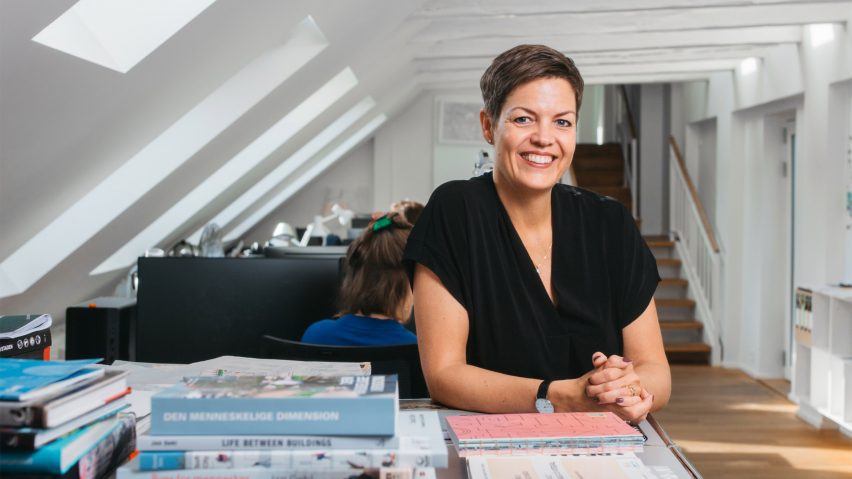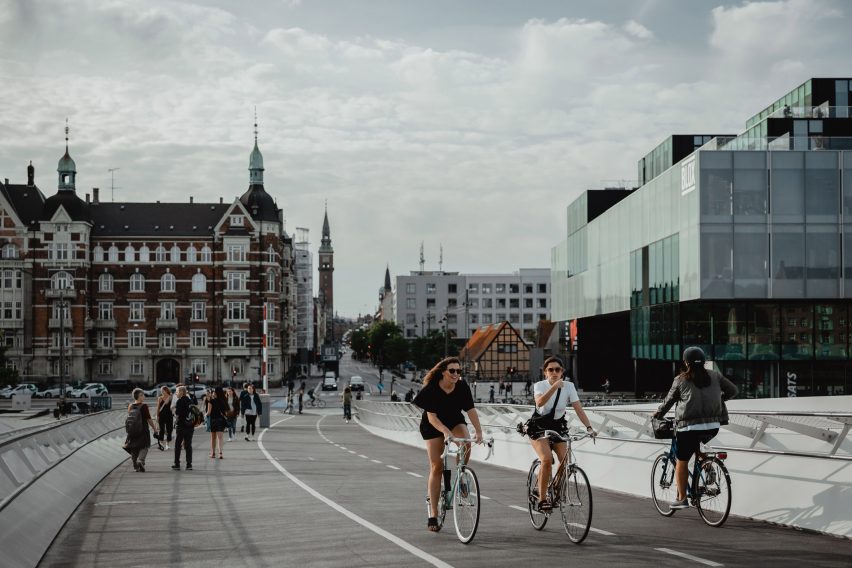
"The era of mega-cities should be over" says Helle Søholt
Mega-projects such as The Line should be avoided in favour of improving urban design within existing cities, Gehl Architects CEO Helle Søholt says in this interview.
Speaking to Dezeen ahead of the UIA World Congress of Architects conference, Danish urban planning and design expert Søholt argued that it is more important for cities to focus on existing infrastructure.
"In general, I think the era of the mega-cities should be over," she said when asked about The Line, a 170-kilometre linear city being constructed in the Saudi Arabian desert.
"I think we need a much more granular approach to urban development globally where we build on existing urban infrastructure, because there are definitely opportunities to get more out of the resource investments that we've done in previous generations," she added.
"So from a sustainability point of view, and from a social sustainability point of view, I think we need to better utilise the infrastructure investments that we've already made before engaging in these new mega-projects."
The Line is part of the wider Neom development, which also includes an octagonal port city masterplanned by fellow Copenhagen architecture studio BIG, and is among a number of new cities being planned around the globe.
There has been an "acceptance of the ideas" about social sustainability
Søholt is one of the session chairs at the UIA World Congress of Architects conference, which is taking place in Copenhagen this week as part of its UNESCO World Capital of Architecture 2023 title.
She co-founded Gehl Architects in 2000 along with the veteran urban designer Jan Gehl, whose philosophy of prioritising pedestrians, cyclists and public space in cities based on research about human behaviour has been hugely influential in the Danish capital.
The city is now frequently ranked among the world's most liveable.
Having studied in his urban design department at Copenhagen's School of Architecture during the 1990s, Søholt was invited by Jan Gehl to help set up his studio when she was just 28.
"At that age, I didn't have any leadership experience, but when you build a practice you basically build the plane while flying it, and sort of build competencies of the practice at the same time as you're developing your own leadership skills," she recalled.
Gehl Architects was established to implement the ideas that Gehl had been advocating for decades.
Around the turn of the millennium, the concept of human-centric urban design was far from the mainstream and in its early years the practice mostly campaigned on "changing the planning paradigm" away from prioritising transport networks, Søholt explained.
"Back then there was not the same focus on sustainability, there was not the same focus on social sustainability and social aspects, making surveys about what people do and like and what they need in urban developments," she said.
More recently – particularly since the coronavirus pandemic highlighted the value of green public spaces and healthy communities – many cities around the world have started to embrace the approach.
"To a large extent there has been an acceptance of the ideas, but now we need to go deeper," said Søholt.
While she says it is "absolutely amazing" that the arguments Gehl Architects has been making for two decades have gained so much momentum, she warns that more action is still needed.
"There is still a risk that we go back to our old ways of modus operandi because the policies haven't necessarily changed and the processes in cities haven't necessarily caught up, so we have a long way to go on that front," she argued.
"This is not about control"
Politics are increasingly a major challenge, with initiatives to increase walking and cycling options and reduce car usage often highly divisive.
Earlier this year conspiracy theories emerged around the 15-minute city concept, with a UK politician claiming in parliament that the idea seeks to "take away personal freedoms".
"A larger and larger and more vocal part of our societies are against 'systems'," reflected Søholt. "Whatever system it is, they're just against it. So they resent plans, they resent policy, they resent anything that is seen as control."
Søholt argues that rather than limiting people's freedom, adding more transport alternatives opens it up.
"I have never felt as limited in my personal freedom as when I lived in the US and I could only get around by car," she said.
"In Copenhagen where I live now, I can choose whatever mode of transportation that is most useful for my trip – I can walk, I can bike, I can take the metro, I can take my car, I can take a train. This is not about control and limiting people, it's about opening up."
To navigate these challenges, Gehl Architects uses a combination of data about people's behaviours and close engagement with communities to deliver its projects.

"We have to bridge the development of policies and systems with the basic daily needs of people," Søholt explained. "That's why I'm so focused on deep listening, understanding people's needs, engaging people and using data to support our decision-making."
"We try to build upon people's real needs and needs that people have been advocating for themselves. Because in that sense, there is a greater chance that they will keep advocating for it."
This focus on democracy and engagement dovetails with the promise at the heart of this year's UIA congress, which is "leave no-one behind".
"That whole more holistic approach to urban development that Copenhagen to a large extent has been successful with is definitely an overarching driver for a lot of the content," remarked Søholt.
Although Søholt admits that promoting cycling and walking was initially more about the social benefits than sustainability for Gehl Architects, the concept has become a major plank of many cities' climate strategies.
"We need cities like Copenhagen to keep innovating"
Now she believes that Copenhagen has an opportunity and an obligation to be a world leader in the push for reducing consumption and waste in cities.
"If we are to keep being the leader within urban development we definitely need to go further into some of these topics," she said.
"Copenhagen has proven that it is possible to change lifestyles; we didn't have 50 per cent of the population cycling, and now we do. But in order to take it to the next level we need more of these lifestyle changes."
For example, it must attempt to leverage its status as one of the world's most successful cities by pushing harder on the transition to a circular economy, she argued.
"I think there's definitely a risk that Copenhagen will now rest on its laurels and fall back – just celebrate all the good that has happened and fall behind," she said.
"We need cities like Copenhagen to really keep innovating," she added. "So the whole circular economy – like how can we have material banks in a city, how can we have resource hubs where people can manage waste in new ways – that's a huge topic that I don't think the city of Copenhagen has yet completely solved."
The City of Copenhagen is introducing 750 new waste sorting stations by 2024, but Søholt believes that monitoring how people use them will be more important than physical infrastructure itself in the move towards circularity.
She refers to this concept as "enabled emissions" – which goes a step further than the embodied emissions within buildings and manufactured goods.
"The city is like a rail track on which our behaviour runs," she said. "If we change the rail track, we can also impact people's behaviour and lifestyle choices on an everyday basis."
"We need to not only think about the emissions that are built into built environments, we also need to include the enabled emissions based on what people do."
The portrait is courtesy of Gehl Architects.
Dezeen in Depth
If you enjoy reading Dezeen's interviews, opinions and features, subscribe to Dezeen In Depth. Sent on the last Friday of each month, this newsletter provides a single place to read about the design and architecture stories behind the headlines.